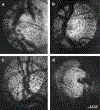Optical Coherence Tomography and Glaucoma
- PMID: 34242054
- PMCID: PMC9184968
- DOI: 10.1146/annurev-vision-100419-111350
Optical Coherence Tomography and Glaucoma
Abstract
Early detection and monitoring are critical to the diagnosis and management of glaucoma, a progressive optic neuropathy that causes irreversible blindness. Optical coherence tomography (OCT) has become a commonly utilized imaging modality that aids in the detection and monitoring of structural glaucomatous damage. Since its inception in 1991, OCT has progressed through multiple iterations, from time-domain OCT, to spectral-domain OCT, to swept-source OCT, all of which have progressively improved the resolution and speed of scans. Even newer technological advancements and OCT applications, such as adaptive optics, visible-light OCT, and OCT-angiography, have enriched the use of OCT in the evaluation of glaucoma. This article reviews current commercial and state-of-the-art OCT technologies and analytic techniques in the context of their utility for glaucoma diagnosis and management, as well as promising future directions.
Keywords: OCT; glaucoma; imaging; optical coherence tomography.
Figures







References
-
- Adhi M, Liu JJ, Qavi AH, Grulkowski I, Lu CD, et al. 2014. Choroidal analysis in healthy eyes using swept-source optical coherence tomography compared to spectral domain optical coherence tomography. Am. J. Ophthalmol 157:1272–81.e1 - PubMed
-
- Alnawaiseh M, Lahme L, Müller V, Rosentreter A, Eter N. 2018. Correlation of flow density, as measured using optical coherence tomography angiography, with structural and functional parameters in glaucoma patients. Graefes Arch. Clin. Exp. Ophthalmol 256:589–97 - PubMed
-
- Arend O, Plange N, Sponsel WE, Remky A. 2004. Pathogenetic aspects of the glaucomatous optic neuropathy: fluorescein angiographic findings in patients with primary open angle glaucoma. Brain Res. Bull 62:517–24 - PubMed
-
- Asaoka R, Murata H, Hirasawa K, Fujino Y, Matsuura M, et al. 2019. Using deep learning and transfer learning to accurately diagnose early-onset glaucoma from macular optical coherence tomography images. Am. J. Ophthalmol 198:136–45 - PubMed
Publication types
MeSH terms
Grants and funding
LinkOut - more resources
Full Text Sources
Medical

